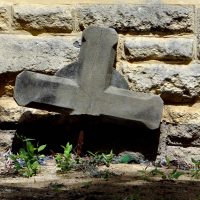
We continue with some final evidences of Jesus’ existence. The persecution of early Christians continued in the Roman empire. In Asia Minor (or modern day Turkey), Pliny the Younger was writing to Emperor Trajan in the second century seeking advice. Since so many Christians had been killed, whether young or old, male or female, Pliny wondered if he should execute only certain ones. Explaining his actions, Pliny wrote that he had found some people falsely accused of being Christian. Upon investigation, they summarily “cursed Christ–none of which those who are really Christians, it is said, can be forced to do.” However, the real Christians were simply “guilty” of the following:
“They asserted, however, that the sum and substance of their fault or error had been that they were accustomed to meet on a fixed day before dawn and sing responsively a hymn to Christ as to a god, and to bind themselves by oath, not to some crime, but not to commit fraud, theft, or adultery, not falsify their trust, nor to refuse to return a trust when called upon to do so.”
Of what were the Christians “guilty”? Promising not to lie, steal, or commit adultery, and worshipping Jesus as the Son of God early in the morning through songs. When Jesus Himself was on trial, He admitted that He was the Son of God in Mark 14:61-62. “Again the high priest asked him, ‘Are you the Christ, the Son of the Blessed One?’ ‘I am,’ said Jesus. ‘And you will see the Son of Man sitting at the right hand of the Mighty One and coming on the clouds of heaven.’” That’s why these early Christians could sing to Jesus as the Son of God; He confessed to it under oath! In another case, the Apostle Thomas also worshipped Jesus in John 20:28-29. “Thomas said to him, ‘My Lord and my God!’ Then Jesus told him, ‘Because you have seen me, you have believed; blessed are those who have not seen and yet have believed.’”
Obviously, not all people in the first and second centuries believed that Jesus was the Son of God and rose from the dead. But they knew of His life and teaching and made reference to it. A final example comes from Mara Bar-Serapion, a first century Syrian philosopher who wrote a letter encouraging his son to pursue wisdom. Among other wise, notable figures in history like Socrates and Pythagoras, Mara Bar-Serapion cites Jesus as an example. “But Socrates did not die for good; he lived on in the teaching of Plato. Pythagoras did not die for good; he lived on in the statue of Hera. Nor did the wise king die for good; he lived on in the teaching which he had given.” Jesus’ teaching did live on in the Great Commission that He gave to His Apostles after His resurrection in Matthew 28:18-20. “Then Jesus came to them and said, ‘All authority in heaven and on earth has been given to me. Therefore go and make disciples of all nations, baptizing them in the name of the Father and of the Son and of the Holy Spirit, and teaching them to obey everything I have commanded you. And surely I am with you always, to the very end of the age.’”
Miami University history professor Edwin Yamauchi summarizes these non-Christian sources from the first and second centuries, recording that Jesus was a teacher from Nazareth and lived a wise and virtuous life. He had enemies who admitted that he did unusual feats they called “sorcery.” He was crucified in Palestine under Pontius Pilate during the reign of Tiberius Caesar at Passover time, being considered the Jewish King. He was believed by his disciples to have been resurrected three days later. He had a small band of disciples that multiplied rapidly, spreading as far as Rome. These disciples denied polytheism, lived moral lives, and worshiped Him as God. There are consistent biblical and historical records of the same basic facts about Jesus that are undeniable.
Learn how to defend your Christian Faith

Big Questions Biblical Answers Supplemental Materials
by Brad Alles
- September 2022
- August 2022
- July 2022
- June 2022
- May 2022
- April 2022
- March 2022
- February 2022
- January 2022
- December 2021
- November 2021
- October 2021
- September 2021
- August 2021
- July 2021
- June 2021
- May 2021
- April 2021
- March 2021
- February 2021
- January 2021
- December 2020
- November 2020
- October 2020
- September 2020
- August 2020
- July 2020
- June 2020
- May 2020
- April 2020
- March 2020
- February 2020
- January 2020
- December 2019
- November 2019
- October 2019
- September 2019
- August 2019
- July 2019
- June 2019
- May 2019
- April 2019
- March 2019
- February 2019
- January 2019
- December 2018
- November 2018
- October 2018
- September 2018
- August 2018
- July 2018
- June 2018
- May 2018
- April 2018
- March 2018
- February 2018
- January 2018
- December 2017
- November 2017
- October 2017
- September 2017
- August 2017
- July 2017
- June 2017
- May 2017
- April 2017
- March 2017
- February 2017
- January 2017
- December 2016
- November 2016
- October 2016
- September 2016
- August 2016
- July 2016
- June 2016
- May 2016
- April 2016
- March 2016
- February 2016
- January 2016
- December 2015
- November 2015
- October 2015
- September 2015
- August 2015
- July 2015
- May 2015
- April 2015
- March 2015
- February 2015
- January 2015
- December 2014
- November 2014
- October 2014
- September 2014
- August 2014
- July 2014
- June 2014
- May 2014
- April 2014
- March 2014
- February 2014
- January 2014
- December 2013
- November 2013
- October 2013
- September 2013
- August 2013
- July 2013
- June 2013
- May 2013
- April 2013
- March 2013
- February 2013
- January 2013
- December 2012
- November 2012
- October 2012
- September 2012
- August 2012
- July 2012
- June 2012
- May 2012
- April 2012
- March 2012
- February 2012
- January 2012














Comments are closed.